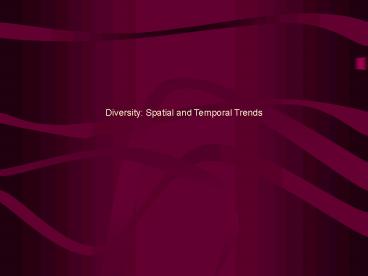Diversity: Spatial and Temporal Trends
Title:
Diversity: Spatial and Temporal Trends
Description:
In Living Conditions: Biotic Provinces. This diagram shows the marine biotic provinces of present-day Earth ... Biotic revolutions resulting from new ways of life ... –
Number of Views:42
Avg rating:3.0/5.0
Title: Diversity: Spatial and Temporal Trends
1
Diversity Spatial and Temporal Trends
2
Global Diversity Gradient
Global diversity measured by number of species
that occupy given habitat or area Latitudinal
Gradient Strong diversity gradient from pole to
pole among both land and marine species In
general, diversity higher in low latitudes than
high latitudes Longitudinal Differences in
Diversity Less predictable than latitudinal
gradients Controlled mainly by geographic or
local to regional climatic barriers
3
Product of Latitudinal and Longitudinal
Differences In Living Conditions Biotic
Provinces
This diagram shows the marine biotic provinces of
present-day Earth
4
Controls on Latitudinal Diversity Gradients
Why is there a gradient in diversity between
poles ? Most obvious factor characteristics of
climate But what does climate impose on
diversity ? Key controlling factor availability
of food resources
5
Two Big Controls on food availability
Temperature some biological processes cannot
efficiently operate under certain conditions
(e.g. tissues can freeze) Light necessary for
photosynthesis note that it is dark for much of
the year in polar regions BUT then why dont
organisms simply adapt to these conditions Note
1. Some bacteria can live below 0o C and others
possibly above 100o C 2. Organisms survive just
fine in deep sea where sunlight is practically
non-existent So must be something other than
simply extreme conditions
6
An important control on diversity STABILITY of
living conditions
Diversity especially high in low latitudes due to
stability of temperature and light conditions
(more constant supply of food). This, in turn, is
connected to the Earths tilt (if Earth wasnt
tilted, We wouldnt have seasons, right ?).
Pretty simple, but perhaps not particularly
obvious because we are trained to think in terms
of thinking about static conditions !
High stability of living conditions permits ways
of life to be more finely divided than in areas
with extreme seasonality
SoA general rule Species of polar regions tend
to be generalists whereas species of equatorial
regions tend to be specialists
7
Longitudinal Controls on Diversity
Again, stability of conditions is key e.g. in
marine realm, temperature more stable in and
around small land masses such as islands than
large masses such as big continents. Diversity
is correspondingly high in small land
masses. Also, important are geographic barriers
which isolate groups of species from one
another In addition, local variations in
conditions due to effects of ocean currents, etc.
impose a great effect on diversity. Even
elevated primary productivity in certain areas
can affect diversity
8
Plate Tectonics Significant in terms of both
spatial and temporal variations in
diversity Create barriers in dispersal Also
affect nutrient flux in Earth system (seafloor
spreading Increases carbon flux to ocean,
increase primary productivity and possibly an
increase in biomass and biodiversity)
9
Note good scattering of continents, high
diversity due to geographic isolation imposed by
barriers (mountains, oceans, etc.) -gene flow
between populations restricted
10
Note clustering of continents, low biological
diversity due to geographic isolation imposed by
barriers (mountains, oceans, etc.) -gene flow
between populations at a maximum
11
Add two other ingredients Biotic revolutions
resulting from new ways of life (e.g. new
weaponry and protective devices resulting from
arms race) Mass extinctions tearing down stage
sets, allowing new stage designs to be
developed. From square one (i.e. the Vendian),
what would primitive metazoans have eaten and
how would community dynamics have changed through
time ? How do organisms maximize obtaining food
on the seafloor ?
12
Jack Sepkoskis Three Great Evolutionary
Faunas Diversity of marine families through time
Soft bodied fauna
Modern fauna
Paleozoic fauna
Cambrian fauna
Cambrian fauna trilobites, inarticulate
brachiopods, primitive molluscs
echinoderms Paleozoic fauna articulate
brachiopods, crinoids, cephalopods, corals,
ostracods Modern fauna mostly gastropods,
bivalves, bony fishes, crabs lobsters, echinoids
13
END OF LECTURE































